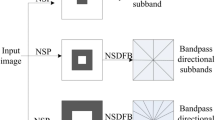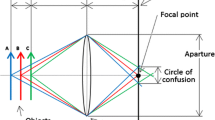Abstract
In this paper, a new multi-focus image fusion algorithm based on L1 image transform is proposed. A distinctive advantage of the proposed algorithm is that an edge-preserving image decomposition (EPID) framework is constructed by introducing a L1-norm based image transform, which can not only effectively preserve and sharpen salient edges and ridges while eliminating insignificant details in the smoothing subband, but also maintain the detail information in the detail subbands. Another advantage is that the fusion rules for the smoothing subband and detail subbands are designed respectively according to their own characteristics so that both the structure and detail information can be fully retained. The fusion process mainly consists of the following three steps. Firstly, each source image is decomposed into a smoothing subband and several detail subbands by utilizing the EPID framework. Then, the subbands are fused by different fusion rules respectively to obtain a fused smoothing subband and a series of fused detail subands. Finally, the final fused image is reconstructed with less distortions by synthesizing the fused smoothing subband and a series of fused detail subands. Experimental results demonstrate the superiority of the proposed algorithm in terms of the visual perception and objective assessments.















Similar content being viewed by others
References
Amin-Naji M, Aghagolzadeh A (2018) Multi-focus image fusion in dct domain using variance and energy of laplacian and correlation coefficient for visual sensor networks. Journal of AI and Data Mining 6(2):233–250
Ardeshir GA, Nikolov S (2007) Guest editorial: Image fusion: Advances in the state of the art. Information Fusion 8(2):114–118
Aslantas V, Kurban R (2010) Fusion of multi-focus images using differential evolution algorithm. Expert Syst Appl 37(12):8861–8870
Bai X, Zhou F, Xue B (2011) Edge preserved image fusion based on multiscale toggle contrast operator. Image Vis Comput 29(12):829–839
Banharnsakun A (2019) Multi-focus image fusion using best-so-far abc strategies. Neural Comput Applic 31(7):2025–2040
Bavirisetti DP, Xiao G, Zhao J, Dhuli R, Liu G (2019) Multi-scale guided image and video fusion: a fast and efficient approach. Circuits, Systems, and Signal Processing 38(12):5576–5605
Bi S, Han X, Yizhou Y (2015) An l 1 image transform for edge-preserving smoothing and scene-level intrinsic decomposition. ACM Trans Graphics (TOG) 34(4):1–12
Burt P, Adelson E (1983) The laplacian pyramid as a compact image code. IEEE Trans Commun 31(4):532–540
Costa MGF, Pinto KMB, Fujimoto LBM, Ogusku MM, Costa Filho CFF (2019) Multi-focus image fusion for bacilli images in conventional sputum smear microscopy for tuberculosis. Biomedical Signal Process Control 49:289–297
Do MN, Vetterli M (2005) The contourlet transform: an efficient directional multiresolution image representation. IEEE Trans Image Process 14 (12):2091–2106
Farbman Z, Fattal R, Lischinski D, Szeliski R (2008) Edge-preserving decompositions for multi-scale tone and detail manipulation. ACM Trans Graphics (TOG) 27(3):1–10
Farid MS, Mahmood A, Al-Maadeed SA (2019) Multi-focus image fusion using content adaptive blurring. Information Fusion 45:96–112
Garg R, Gupta P, Kaur H (2014) Survey on multi-focus image fusion algorithms. In: 2014 Recent advances in engineering and computational sciences (RAECS), IEEE, pp 1–5
Gong Y, Sbalzarini IF (2017) Curvature filters efficiently reduce certain variational energies. IEEE Trans Image Process 26(4):1786–1798
Haghighat MBA, Aghagolzadeh A, Seyedarabi H (2010) Real-time fusion of multi-focus images for visual sensor networks. In: 2010 6Th iranian conference on machine vision and image processing, IEEE, pp 1–6
Hayat N, Imran M (2019) Ghost-free multi exposure image fusion technique using dense sift descriptor and guided filter. J Vis Commun Image Represent 62:295–308
Huang W, Jing ZL (2007) Evaluation of focus measures in multi-focus image fusion. Pattern Recogn Lett 28(4):493–500
Lewis JJ, O’Callaghan RJ, Nikolov SG, Bull DR, Canagarajah N (2007) Pixel-and region-based image fusion with complex wavelets. Information Fusion 8(2):119–130
Li T, Wang Y (2011) Biological image fusion using a nsct based variable-weight method. Information Fusion 12(2):85–92
Li S, Yang B (2008) Multifocus image fusion using region segmentation and spatial frequency. Image Vis Comput 26(7):971–979
Li S, Yang B (2008) Multifocus image fusion by combining curvelet and wavelet transform. Pattern Recognition letters 29(9):1295–1301
Li S, Kang X, Jianwen H, Yang B (2013) Image matting for fusion of multi-focus images in dynamic scenes. Information Fusion 14(2):147–162
Li H, Liu X, Zhengtao Y, Zhang Y (2016) Performance improvement scheme of multifocus image fusion derived by difference images. Signal Process 128:474–493
Li H, Qiu H, Zhengtao Y, Bo L (2017) Multifocus image fusion via fixed window technique of multiscale images and non-local means filtering. Signal Process 138:71–85
Liu X, Mei W, Huiqian D (2016) Multimodality medical image fusion algorithm based on gradient minimization smoothing filter and pulse coupled neural network. Biomedical Signal Processing and Control 30:140–148
Liu Y, Chen X, Peng H, Wang Z (2017) Multi-focus image fusion with a deep convolutional neural network. Information Fusion 36:191–207
Liu S, Chen J, Rahardja S (2019) A new multi-focus image fusion algorithm and its efficient implementation. IEEE Trans Circ Syst Video Technol 30 (5):1374–1384
Ma J, Zhou Z, Bo W, Dong M (2017) Multi-focus image fusion based on multi-scale focus measures and generalized random walk. In: 2017 36Th chinese control conference (CCC), IEEE, pp 5464–5468
May KA, Georgeson MA (2007) Blurred edges look faint, and faint edges look sharp: the effect of a gradient threshold in a multi-scale edge coding model. Vis Res 47(13):1705–1720
Min D, Choi S, Jiangbo L, Ham B, Sohn K, Do MN (2014) Fast global image smoothing based on weighted least squares. IEEE Trans Image Process 23(12):5638–5653
Pajares G, De La Cruz JM (2004) A wavelet-based image fusion tutorial. Pattern Recogn 37(9):1855–1872
Piccinini F, Tesei A, Zoli Ws, Bevilacqua A (2012) Extended depth of focus in optical microscopy: Assessment of existing methods and a new proposal. Microsc Res Tech 75(11):1582–1592
Piella G, Heijmans H (2003) A new quality metric for image fusion. In: Proceedings 2003 International Conference on Image Processing (Cat. No. 03CH37429), vol 3, IEEE, pp III–173
Qiu X, Li M, Zhang L, Yuan X (2019) Guided filter-based multi-focus image fusion through focus region detection. Signal Process Image Commun 72:35–46
Selesnick IW, Baraniuk RG, Kingsbury NC (2005) The dual-tree complex wavelet transform. IEEE Signal Process Magazine 22(6):123–151
Tan W, Zhou H, Rong S, Qian K, Yue Y (2018) Fusion of multi-focus images via a gaussian curvature filter and synthetic focusing degree criterion. Appl Opt 57(35):10092–10101
Tian J, Li C, Ma L, Weiyu Y (2011) Multi-focus image fusion using a bilateral gradient-based sharpness criterion. Optics Commun 284(1):80–87
Wang Z, Bovik AC, Sheikh HR, Simoncelli EP (2004) Image quality assessment: from error visibility to structural similarity. IEEE Trans Image Process 13(4):600–612
Xydeas CS, Petrovic V (2000) Objective image fusion performance measure. Electron Lett 36(4):308–309
Yan T, Hu Z, Qian Y, Qiao Z, Zhang L (2020) 3d shape reconstruction from multifocus image fusion using a multidirectional modified laplacian operator. Pattern Recogn 107065:98
Yi C, Li H, Li Z (2011) Multifocus image fusion scheme using focused region detection and multiresolution. Opt Commun 284(19):4376–4389
Zhan K, Li Q, Teng J, Wang M, Shi J (2015) Multifocus image fusion using phase congruency. Journal of Electronic Imaging 24(3):033014
Zhan K, Teng J, Li Q, Shi J et al (2015) A novel explicit multi-focus image fusion method. Journal of Information Hiding and Multimedia Signal Processing 6(3):600–612
Zhang Y, Bai X, Wang T (2017) Boundary finding based multi-focus image fusion through multi-scale morphological focus-measure. Information Fusion 35:81–101
Zhao H, Qi L, Feng H (2008) Multi-focus color image fusion in the hsi space using the sum-modified-laplacian and a coarse edge map. Image Vis Comput 26(9):1285–1295
Zhou Z, Li S, Bo W (2014) Multi-scale weighted gradient-based fusion for multi-focus images. Information Fusion 20:60–72
Zhu Z, Yin H, Yi C, Li Y, Qi G (2018) A novel multi-modality image fusion method based on image decomposition and sparse representation. Inf Sci 432:516–529
Acknowledgements
The work was supported in part by the National Natural Science Foundation of China under Grant 61801190 and 61272209, in part by the Nature Science Foundation of Jilin Province under Grant 20180101055JC, in part by the Outstanding Young Talent Foundation of Jilin Province under Grant 20180520029JH, in part by the China Postdoctoral Science Foundation under Grant 2017M611323, in part by the Industrial Technology Research and Development Funds of Jilin Province under Grant 2019C054-3, and in part by the National Science & Technology Pillar Program of China under Grant 2012BAH48F02.
Author information
Authors and Affiliations
Corresponding author
Additional information
Publisher’s note
Springer Nature remains neutral with regard to jurisdictional claims in published maps and institutional affiliations.
Rights and permissions
About this article
Cite this article
Yu, S., Li, X., Ma, M. et al. Multi-focus image fusion based on L1 image transform. Multimed Tools Appl 80, 5673–5700 (2021). https://doi.org/10.1007/s11042-020-09877-4
Received:
Revised:
Accepted:
Published:
Issue Date:
DOI: https://doi.org/10.1007/s11042-020-09877-4




